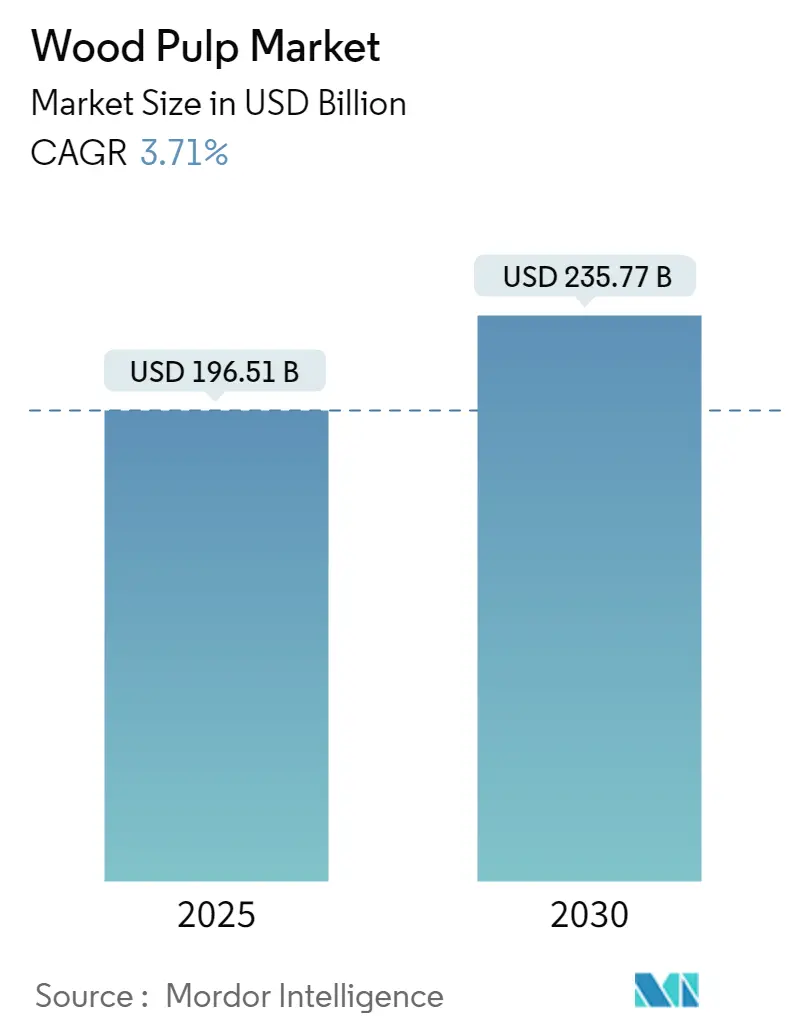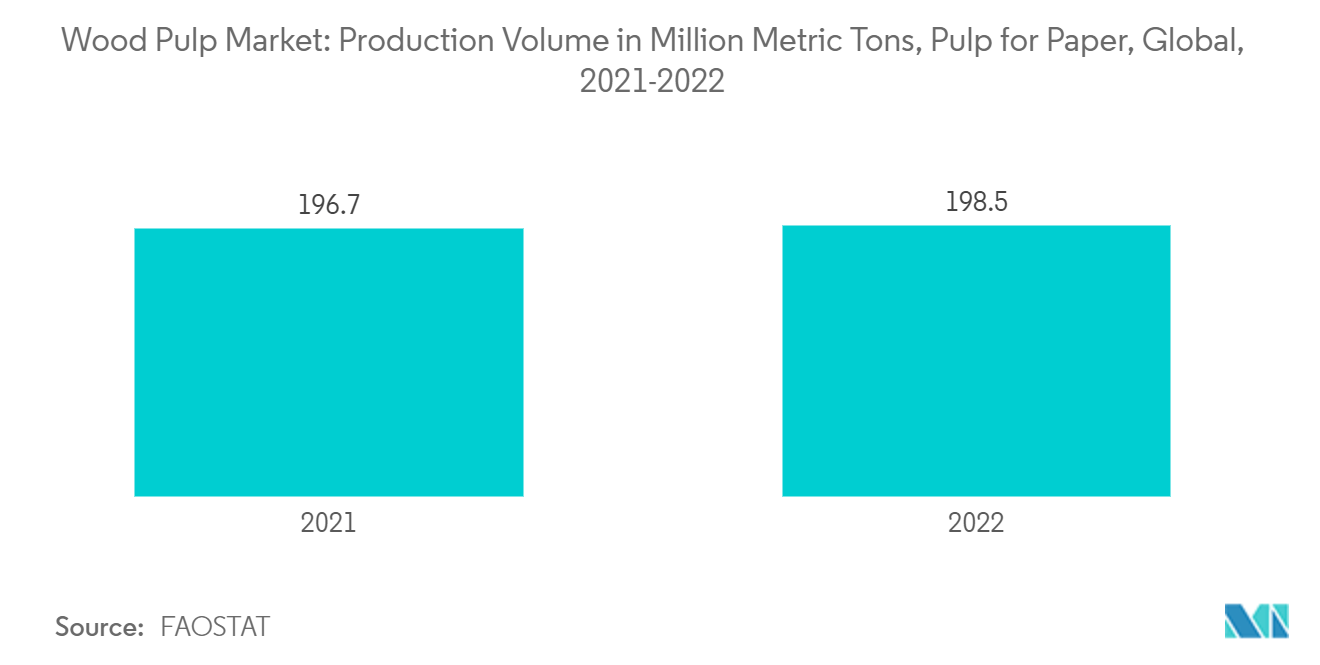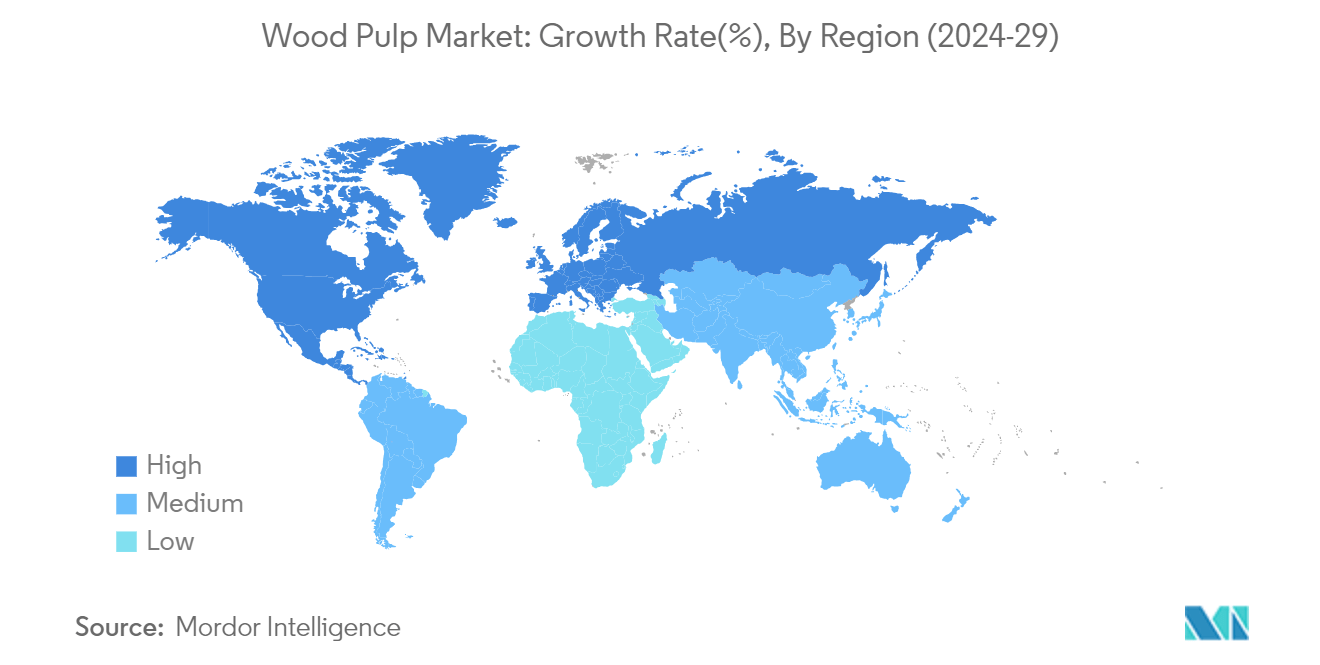
| Study Period | 2019 - 2030 |
| Market Size (2025) | USD 196.51 Billion |
| Market Size (2030) | USD 235.77 Billion |
| CAGR (2025 - 2030) | 3.71 % |
| Fastest Growing Market | Asia-Pacific |
| Largest Market | North America |
| Market Concentration | Medium |
Wood Pulp Market Analysis
The Wood Pulp Market size is estimated at USD 196.51 billion in 2025, and is expected to reach USD 235.77 billion by 2030, at a CAGR of 3.71% during the forecast period (2025-2030).
- The drivers identified in the market are increasing demand for wood pulp from the paper industry, rising consumer demand for tissue paper products, and growth in the trade of wood pulp products. The restraints identified in the market are stringent environmental regulations concerning deforestation and increasing energy and transportation costs.
- The United States is the world's major producer of wood pulp, and Brazil, China, and Sweden are other major pulp producers. According to ITC Trade data, in 2023, the total import of wood pulp was about 3.3 million metric tons. China, India, Egypt, and Korea are major importers of wood pulp. In 2023, China imported more than 41% of the total import quantity, which was 1.3 million metric tons.
- The main grades of pulp are chemical pulp, mechanical and semi-chemical pulp, and other pulp. According to FAO data, in 2022, 84.5% of chemical pulp grade and 15.5% of mechanical and semi-chemical grade were produced out of the 186 million metric tons of production volume recorded in the same year.
- The paper industry is one of the major consumers of wood pulp. In 2022, according to data from FAOstat, the leading pulp producers were the United States with 46.5 million metric tons, Brazil with 24.9 million metric tons, and China with 21 million metric tons. Other major producers included Canada, Sweden, and Finland.
Wood Pulp Market Trends
Rising Consumer Demand for Paper Products is Driving the Market
The market for tissue paper is experiencing a surge in demand, driven by increased awareness of personal hygiene and sanitation and a growing preference for sustainable products. As consumers seek eco-friendly alternatives, manufacturers are increasingly adopting wood fibers and recycled paper pulp in their production processes. To meet this rising demand, the production of wood pulp has been increasing steadily. According to ITC Trade Map, the global production volume of wood pulp was 195 million metric tons in 2023.
The United States, with an average annual consumption of 25 kg per person, remains the world's largest tissue paper consumer. Kitchen towels account for a significant portion of this demand. Canada, renowned for its extensive boreal forests, plays a pivotal role in the global pulp and paper industry, supplying domestic and international markets.
Moreover, there is an increase in demand for paper and paper board industry, which also relies on wood pulp. According to ITC Trade Map, the global import value of paper and paperboard products reached USD 188.20 billion in 2023. Major importers in this market include the United States, Germany, France, and the United Kingdom, while leading exporters are China, Germany, the United States, and Sweden.

United States is the Largest Producer
The United States is the world's leading producer of wood pulp, a raw material essential for the paper industry. This dominance is largely attributed to its vast coniferous forests, which provide a plentiful supply of the necessary timber. In 2022, the United States accounted for nearly 25% of global wood pulp production, with output reaching about 46.5 million metric tons, according to the Food and Agriculture Organization (FAO). The country's paper industry is also home to some of the world's largest companies, including International Paper, Georgia-Pacific, and Weyerhaeuser, operating in numerous countries.
The export landscape has shifted in recent years. From 2019 to 2023, wood pulp exports from the United States increased by 19.4%, reaching 49,880 metric tons. This trend is driven by a combination of factors, including increasing domestic production, declining domestic consumption, and growing global demand for wood pulp.
The future outlook for the United States wood pulp industry remains positive. As domestic consumption modifies and global demand for paper products persists, the country's exports are expected to expand further. Additionally, advancements in pulp production technology and sustainable forestry practices are likely to enhance the competitiveness of the US wood pulp industry.
Abundant forest resources, a strong paper industry, and growing exports are the major factors anticipated to drive the wood pulp market in the country during the forecast period.
Wood Pulp Market News
- August 2024: Pregis, a global leader in protective packaging solutions, invested in new production lines to increase capacity for its EverTec Mailer portfolio. This expansion reflects Pregis' commitment to meeting the growing demand for sustainable and efficient packaging solutions.
- July 2024: Suzano, a leading global pulp and paper producer, significantly increased its production capacity with the startup of its new mill in Brazil. With an annual capacity of 2.55 million metric tons of eucalyptus pulp, the mill solidified Suzano's position as a major player in the global pulp and paper industry.
- July 2024: Sofidel, a major player in the tissue market, expanded its presence in North America by acquiring Clearwater Paper Corporation's Tissue Business. This acquisition added significant capacity and expertise to Sofidel's operations, enabling the company to meet growing demand better.
- November 2022: Nippon Paper Industries increased the price of its packaging paper by 15% or more for shipments starting December 1, 2022, in Japan. The company stated that this decision was made after its efforts to cut costs, which were unproductive due to the high volatility of the market.
Wood Pulp Industry Segmentation
Wood pulp is made when wood fibers are mechanically or chemically reduced into pulp form. Wood pulp is processed into paper with the help of chemical compounds such as caustic soda. The wood pulp market is segmented by geography (North America, Europe, Asia-Pacific, South America, and Middle East and Africa). The study covers production analysis (volume), consumption analysis (value and volume), export analysis (value and volume), import analysis (value and volume), and price trend analysis of wood pulp at a macro level, in addition to the value chain. The report offers market estimation and forecast in value (USD) and volume (metric tons).
| By Geography | North America | United States | |
| Canada | |||
| Europe | Germany | ||
| United Kingdom | |||
| France | |||
| Asia-Pacific | China | ||
| Australia | |||
| India | |||
| South America | Brazil | ||
| Argentina | |||
| Middle East and Africa | South Africa | ||
| Egypt | |||
Wood Pulp Market Research FAQs
How big is the Wood Pulp Market?
The Wood Pulp Market size is expected to reach USD 196.51 billion in 2025 and grow at a CAGR of 3.71% to reach USD 235.77 billion by 2030.
What is the current Wood Pulp Market size?
In 2025, the Wood Pulp Market size is expected to reach USD 196.51 billion.
Which is the fastest growing region in Wood Pulp Market?
Asia-Pacific is estimated to grow at the highest CAGR over the forecast period (2025-2030).
Which region has the biggest share in Wood Pulp Market?
In 2025, the North America accounts for the largest market share in Wood Pulp Market.
What years does this Wood Pulp Market cover, and what was the market size in 2024?
In 2024, the Wood Pulp Market size was estimated at USD 189.22 billion. The report covers the Wood Pulp Market historical market size for years: 2019, 2020, 2021, 2022, 2023 and 2024. The report also forecasts the Wood Pulp Market size for years: 2025, 2026, 2027, 2028, 2029 and 2030.
Our Best Selling Reports
Wood Pulp Industry Report
The global wood pulp market is on a growth path, fueled by escalating demand for eco-friendly paper and packaging solutions. Technological innovations in both chemical and mechanical pulping processes are broadening the spectrum of wood pulp applications, ranging from newsprint to high-grade papers and packaging materials. This shift towards more sustainable production methods is pivotal in addressing both the global water scarcity and the need for enhanced agricultural productivity. Regionally, the Asia-Pacific market is at the forefront, driven by advancements in agricultural practices and a focus on conservation. Despite facing challenges related to environmental regulations and deforestation, the wood pulp industry is steadfast in adopting water-saving technologies to cater to the soaring global demand. Insights from Mordor Intelligence™ highlight the market's potential expansion and innovation, underlining wood pulp's critical role in the future of sustainable consumer products. Get a sample of this industry analysis as a free report PDF download.





